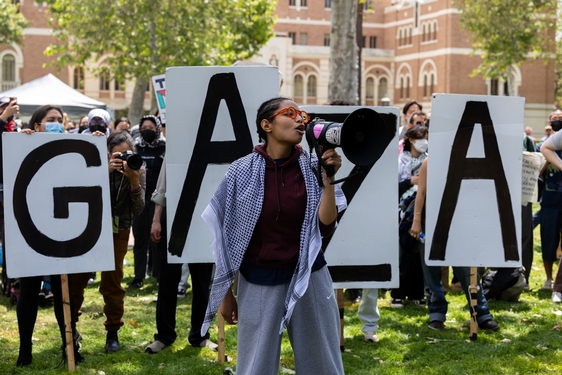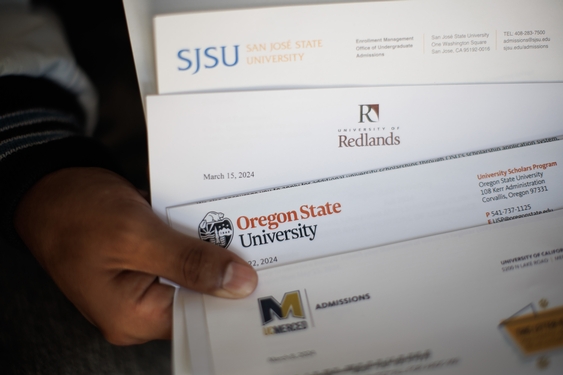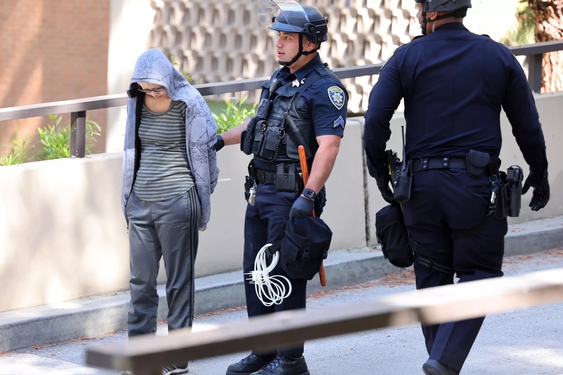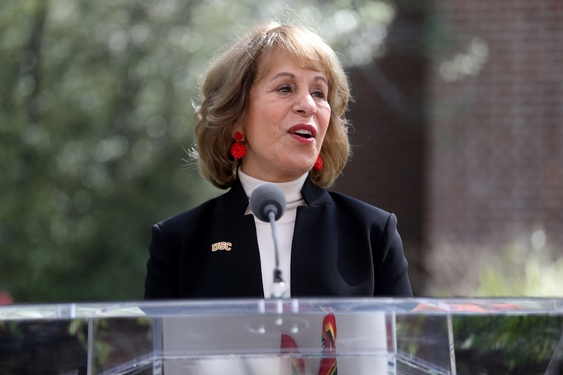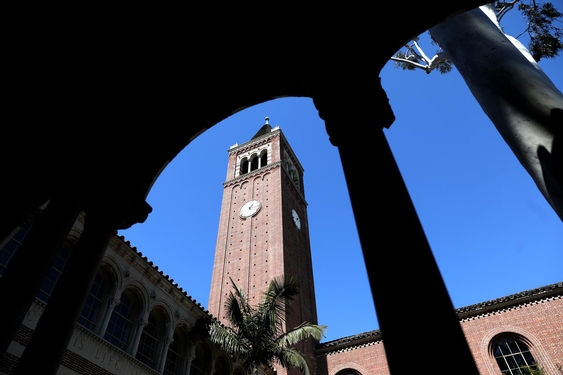Two California colleges have settled for $145,000 in damages in eight months after being sued over restrictions on student protests and political speech.
And as other campuses prepare to begin fall classes, the organization that sued Citrus College and Cal Poly Pomona has a list of more than two dozen schools with restrictive protest and demonstration policies.
On July 23, Cal Poly Pomona settled a lawsuit over a policy that restricted political speech to a 154-square-foot triangle of grass on campus for $35,000.
In the settlement, the university agreed to revise its policies and pay student Nicolas Tomas $35,000 in damages and attorney’s fees. The 24-year-old nutrition major had been handing out pamphlets advocating a vegan lifestyle and attacking the treatment of farm animals. According to Tomas, he mostly worked the sidewalks between the university’s parking garage and the main campus, where he would see most of those coming or going from campus.
Administrators and, eventually, campus police objected, telling him he had to restrict his activities to a “free speech zone” — a little triangle of grass between the university library and student center — and wear a badge, signed by a university administrator, indicating that he had permission to be there.
Earlier this year, the Foundation for Individual Rights in Education, or FIRE, a nonprofit that fights speech restrictions at campuses around the country, sued on Tomas’ behalf in U.S. District Court in Los Angeles. FIRE attacked the university’s policy as a “deprivation of fundamental rights” and sued the university on March 31. Cal Poly suspended its free-speech zone policy in early May and has said that administrators and police who ordered political speech constrained to the free speech area were mistaken and will work to train employees on the actual policy.
The Cal Poly Pomona settlement comes seven months after FIRE won a $110,000 payment from Citrus College in December after a student at the Glendora school sued over the campus’ free-speech area policy. The college settled the case and agreed to expand its zone to most areas on campus and to change procedures to make it easier to speak on campus.
FIRE’s website lists 28 California colleges and universities, both public and private, with what FIRE spokeswoman Katie Barrows calls “restrictive protest and demonstration policies,” including Cal Poly San Luis Obispo, Cal State Channel Islands, Chico State, Cal State Dominguez Hills, Cal State East Bay, Fresno State, Cal State Fullerton, Cal State Long Beach, Cal State Los Angeles, Cal State Monterey Bay, Cal State Northridge, Sacramento State, Cal State San Bernardino, Cal State San Marcos, Humboldt State University, San Diego State University, San Francisco State University, Stanford, UC Riverside, UC Berkeley, UC Davis, UC Irvine, UCLA, UC San Diego, UC Santa Barbara, UC Santa Cruz, UC Merced and USC.
“That doesn’t necessarily mean they have a free-speech zone,” Barrows said. “It could be a number of things that violate the Constitution.”
The California State University system has a Free Speech Handbook that argues against the use of free-speech zones to constrain where and when speech can happen on campuses, except for compelling reasons and, even then, be as narrowly tailored as possible. That doesn’t mean it doesn’t happen, though.
At Cal State San Marcos, how and where public assembly can take place is set out in a university policy:
“The free speech and assembly area is the space in front of University Hall, 60 feet from the front steps of the building extending to the corner of Starbucks. The area also encompasses the space in front of the Craven Rotunda on the third floor up the stairs to the fourth level of Craven. When assembling on the stairs, 6 feet to the extreme left and right must be kept clear for pedestrian passage,” the policy reads in part. “As to nonscheduled events, use of a different location may be permitted in instances such as a protest where the area may have symbolic relevance (e.g. Cesar Chavez statue).”
Cal Poly’s $35,000 settlement hasn’t prompted any discussions about changing that policy so far.
“There hasn’t been any recent conversation about repealing or revising this policy,” said campus spokeswoman Margaret Chantung. (Chantung, like many of those contacted for this report, responded via email.)
Cal State San Bernardino also spells out where free speech can take place, in several large free speech zones on campus, according to campus spokesman Joe Guiterrez, including the lawn in front of the campus library, grassy areas adjacent to the student recreation center and the Commons dining hall and the Commons patio.
“We prefer you to be at those designated spots, because there’s a lot of foot traffic there,” Guiterrez said. “I don’t recall anyone who said ‘Oh no, I want to stay there.’?”
If that happened, though, students wouldn’t be forced to relocate: “We’re not handcuffing anyone here,” Guiterrez said.
Other California State University campuses emphatically do not have free speech zones.
“Our entire campus is a free-speech campus,” said San Diego State spokeswoman Beth Downing Chee.
Cal State Monterey Bay and San Francisco State are among those that broadly allow speech on campus, so long as it doesn’t interfere with other campus activities.
Sonoma State does not have a free speech zone policy, according to spokeswoman Susan Kashack, but it does have something else: Math instructor Mario Savio gained worldwide prominence in 1964 and 1965 as part of the Berkeley Free Speech Movement, which demanded that UC Berkeley administrators lift the ban on on-campus political action and speech.
“Because of who he was (an excellent teacher), what he stood for in the ‘60s, and the strives that were made in that movement, a group of students, faculty, staff and administrators chose to honor Mario by creating a ‘Mario Savio Speakers Corner’ on campus,” Kashack said. “It is used by some groups and not by others, but free speech is not limited to that area.”
The $35,000 settlement agreement with Cal Poly Pomona hasn’t prompted any updates of existing CSU policies or even a systemwide discussion, according to a spokeswoman for Chancellor Timothy P. White.
“All campuses have free speech policies and support free speech,” Laurie Weidner said. “The chancellor’s office has no plans to review campus free speech policies.”
California colleges and universities with ‘restrictive protest and demonstration’ policies
According to FIRE, the Foundation for Individual Rights in Education, the following 28 California colleges and universities, both public and private, have “restrictive protest and demonstration policies:”
• Cal State Channel Islands
• Cal State Dominguez Hills
• Cal State East Bay
• Cal State Fullerton
• Cal State Long Beach
• Cal State Los Angeles
• Cal State Monterey Bay
• Cal State Northridge
• Cal State San Bernardino
• Cal Poly San Luis Obispo
• Cal State San Marcos
• Chico State
• Fresno State
• Humboldt State University
• Sacramento State
• San Diego State University
• San Francisco State University
• Stanford University
• University of California, Berkeley
• University of California, Davis
• University of California, Irvine
• University of California, Los Angeles
• University of California, Merced
• University of California, Riverside
• University of California, Santa Barbara
• University of California, Santa Cruz
• University of California, San Diego
• University of Southern California
———
©2015 the San Bernardino County Sun (San Bernardino, Calif.)
Visit the San Bernardino County Sun (San Bernardino, Calif.) at sbsun.com
Distributed by Tribune Content Agency, LLC.








